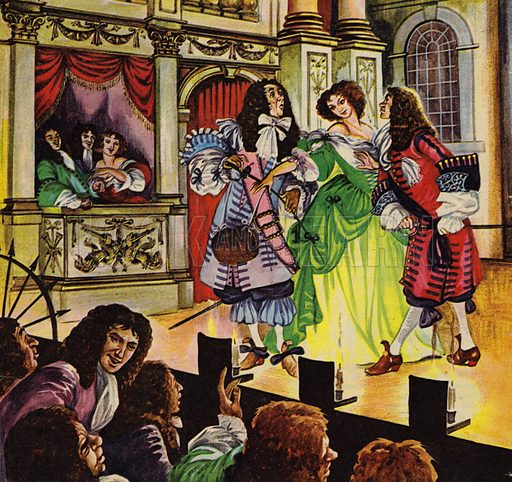
The Restoration
The Restoration was describes the era coinciding with the return of the monarchy in Britain (with King Charles II) when theatre, previously banned by Oliver Cromwell and his Puritan philosophy that frowned upon carnal desires (such as theatre), returned. The plays from this time show this return of fun to the world, often providing rude entertainment in the form of sexual jokes. Comedies were common-place and the main genre of this era.
After the 18 year period from 1642 to 1660 of no theatre, players were used to performing in far smaller spaces such as in taverns or homes which changed the style of theatre when they returned to proper stages. Beyond just entertainment, the restoration heavily focused on satire of the aristocracy and rich, or society as a whole. It hugely resembles Greek Theatre through the numerous sexual innuendos and energetic performance style. Many of the plays were about court life, with its immorality and illusory glory, or the exaggerated and comedically played relationships of people.
The period also birthed the heroic play, a hybrid of comedy and tragedy that evolved from previous dramatic tragedies of the Elizabethan era, from playwrights like Shakespeare. These used themes of chivalry, love and conflict that were less serious and more entertaining, and often portrayed the heroes with supernatural abilities (further drawing parallels to ancient Greece).
Dryden was possibly the most famous writer of the era, responsible for comedies such as 'Marriage a la Mode,' the tragedy or heroic play of 'All for Love' which emulates Shakespeare's 'Anthony and Cleopatra.' This unique genre almost rose and fell with this playwright alone.
This period also marked the entrance of women onto stage, replacing the Shakespearean rule of having men play female roles. Make-up and set design were drastically changed too - highly decorated sets that were decidedly anti-puritan were common and moveable scenery came into use as stage equipment became necessary with more complex plays
PLAYS
John Dryden's 'Marriage a la Mode' was the earliest of the Great Restoration comedies, and contains themes that are echoed through the rest of the era. Intertwining two stories, the play contains plotting, deceit, property arguments and failed marriages. The title originally referred to a series of six paintings by Hogarth that shows the consequences of arranged marriage - scenes of adultery, syphilis, murder and suicide contain the couple and their family and friends. The play contains blank verse, heroic couplets and prose, as well as two songs - this theatre was intended to be humorous and entertaining
'The Country Wife' by William Wycherly is an even more sexual and risque than Dryden's play. It too is a comedy and was even criticised in its own period for how explicit it was. The first syllable of the title itself is intended to be crude joke, and the play is not lacking in these. It is acclaimed by academics today for its energy and sharp social satire amongst the entertainment. As with many plays at the time, there were 3 distinct by connected plots - one of a man feigning impotence to have affairs with married women, one of a married couple and one of a courting couple, to give a full image of particularly romantic relationships within society so that they could be discussed.